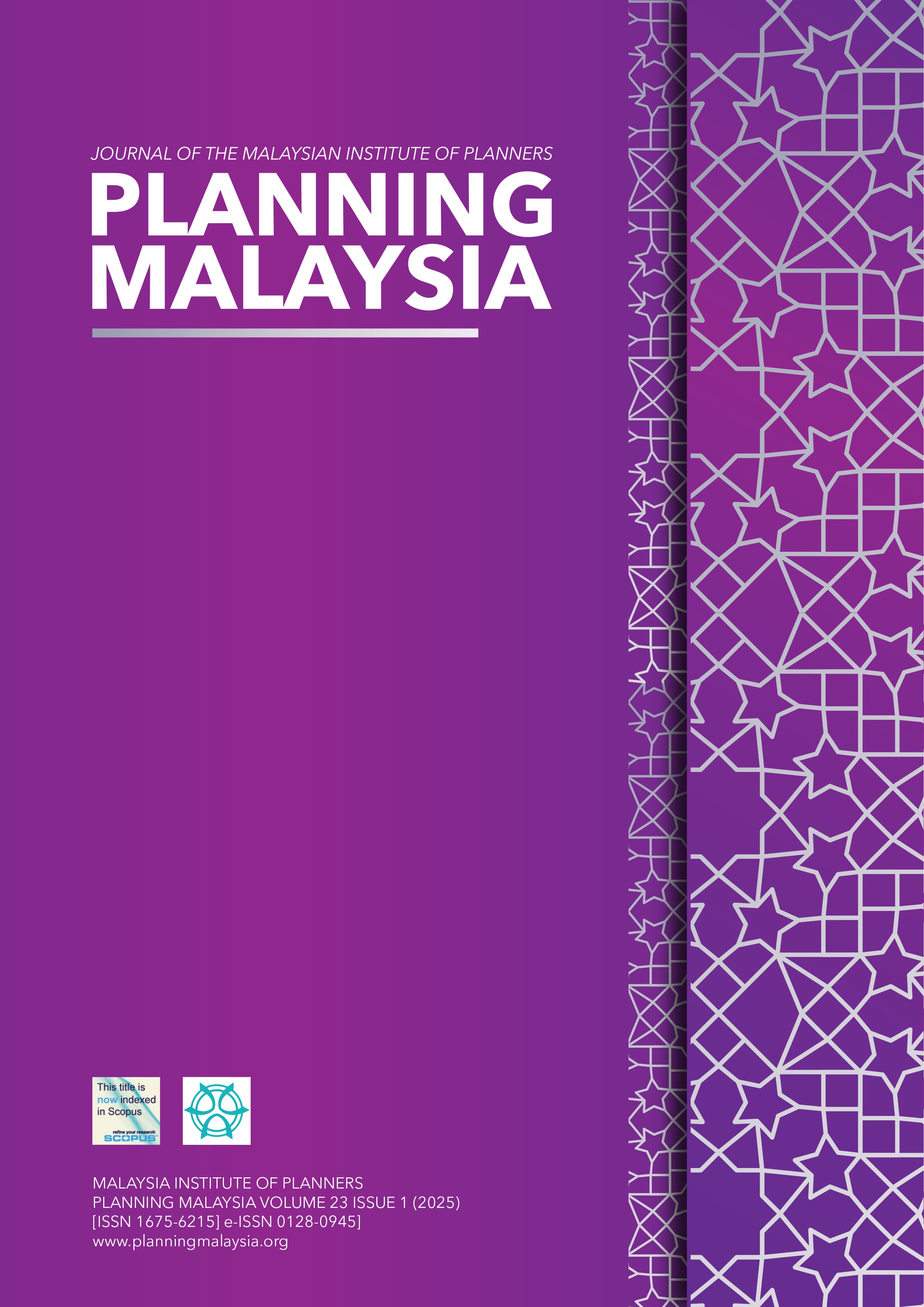SIMULATION MODEL OF GREEN OPEN SPACE ON MICROCLIMATE PERFORMANCE IN TROPICAL COASTAL AREA
DOI:
https://doi.org/10.21837/pm.v23i35.1674Keywords:
Green open space, scenario simulation, air temperature, spatial analysisAbstract
This research aimed to simulate scenario of green open space to mitigate heating within microclimate performance. It also optimized the composition of the built environment's surface to reduce urban heating. A numerical model was simulated using ENVI-met, and spatial analysis was conducted with ArcGIS software. Three different scenarios were established to propose solutions for heating reduction. Simulation showed that a balanced composition between buildings and vegetation resulted in air temperature decrease of 2.45°C to 3.31°C compared to no-greenery simulation. Meanwhile, when compared to the existing situation, hybrid greenery achieved a 3.50°C air temperature decrease. This research offered valuable insights into the urban environment by prioritizing landscape design, focusing on buildings and the composition of green open space in surrounding areas
Downloads
References
Arifwidodo, S. D., Chandrasiri, O., Abdulharis, R., & Kubota, T. (2019). Exploring the effects of urban heat island: A case study of two cities in Thailand and Indonesia. APN Science Bulletin, 9(1), 10–18. https://doi.org/10.30852/sb.2019.539. DOI: https://doi.org/10.30852/sb.2019.539
Broadbent, A. M., Krayenhoff, E. S., & Georgescu, M. (2020). Efficacy of cool roofs at reducing pedestrian-level air temperature during projected 21st century heatwaves in Atlanta, Detroit, and Phoenix (USA). Environmental Research Letters, 15(8), 084007. https://doi.org/10.1088/1748-9326/1b6123 DOI: https://doi.org/10.1088/1748-9326/ab6a23
Chatzidimitriou, A., & Yannas, S. (2015). Microclimate development in open urban spaces: The influence of form and materials. Energy and Buildings, 108, 156-174. https://doi.org/10.1016/j.enbuild.2015.08.048. DOI: https://doi.org/10.1016/j.enbuild.2015.08.048
De Abreu-Harbich, L. V., Labaki, L. C., & Matzarakis, A. (2015). Effect of tree planting design and tree species on human thermal comfort in the tropics. Landscape and Urban Planning, 138, 99-109. https://doi.org/10.1016/j.landurbplan.2015.02.008. DOI: https://doi.org/10.1016/j.landurbplan.2015.02.008
Eni, S., & Hidayati, I. N. (2015). Aplikasi Penginderaan Jauh Untuk Analisis Pengaruh Ruang terbuka Hijau terhadap Iklim Mikro di Kawasan Perkotaan Klaten. Majalah Geografi Indonesia, 29(2), 132–13. https://doi.org/10.22146/mgi.13113. DOI: https://doi.org/10.22146/mgi.13113
Galagoda, R. U., Jayasinghe, G.Y., Halwatura, R.U., & Rupasinghe, H.T. (2018). The impact of urban green infrastructure as a sustainable approach towards tropical micro-climatic changes and human thermal comfort. Urban forestry & urban greening, 34, 1-9. https://doi.org/10.1016/j.ufug.2018.05.008. DOI: https://doi.org/10.1016/j.ufug.2018.05.008
Krayenhoff, E. S., Jiang T, Christen A, Martilli A, Oke TR, Bailey BN, Nazarian N, Voogt JA, Giometto MG, Stastny A, & Crawford BR. A multi-layer urban canopy meteorological model with trees (BEP-Tree): Street tree impacts on pedestrian-level climate. Urban Climate. 2020; 32: 100590. doi: 10.1016/j.uclim.2020.100590. DOI: https://doi.org/10.1016/j.uclim.2020.100590
Krehbiel, C., Zhang, X., & Henebry, G. M. (2017). Impacts of thermal time on land surface phenology in urban areas. Remote Sensing, 9(5), 1-21. https://doi.org/10.3390/rs9050499. DOI: https://doi.org/10.3390/rs9050499
Mutani, G., Todeschi, V., (2019). Matsuo, K. Urban Heat Island Mitigation: A GIS-based Model for Hiroshima. Instrumentation Mesure Métrologie, 18(4), 323–335. https://doi.org/10.18280/i2m.180401. DOI: https://doi.org/10.18280/i2m.180401
Oke, T. R., Mills, G., Christen, A., & Voogt, J.A. (2017). Urban climates. Cambridge University Press. DOI: https://doi.org/10.1017/9781139016476
Oxoli, D., Ronchetti, G., Minghini, M., Molinari, M. E., Lotfian, M., Sona, G., & Brovelli, M. A. (2018). Measuring urban land cover influence on air temperature through multiple Geo-Data—The case of Milan, Italy. ISPRS International Journal of Geo-Information, 7(11), 421. https://doi.org/10.3390/ijgi7110421. DOI: https://doi.org/10.3390/ijgi7110421
Peng, S., Feng, Z., Liao, H., Huang, B., Peng, S., & Zhou, T. (2019). Spatial-temporal pattern of, and driving forces for, urban heat island in China. Ecological indicators, 96, 127-132. https://doi.org/10.1016/j.ecolind.2018.08.059. DOI: https://doi.org/10.1016/j.ecolind.2018.08.059
Ragheb, A. A., El-Darwish, I. I., 7 Ahmed, S. (2016). Microclimate and human comfort considerations in planning a historic urban quarter. International Journal of Sustainable Built Environment, 5(1), 156-167. https://doi.org/10.1016/j.ijsbe.2016.03.003. DOI: https://doi.org/10.1016/j.ijsbe.2016.03.003
Willmott, C. J., & Matsuura, K. (2005). Advantages of the mean absolute error (MAE) over the root mean square error (RMSE) in assessing average model performance. Clim. Res. 30(1), 79-82. https://doi.org/10.1016/j.ufug.2018.03.022. DOI: https://doi.org/10.3354/cr030079
Yahia, M. W., Johansson, E., Thorsson, S., Lindberg, F., & Rasmussen, M.I. (2018). Effect of urban design on microclimate and thermal comfort outdoors in warm-humid Dar es Salaam, Tanzania. International journal of biometeorology, 62, 373-385. https://doi.org/10.1007/s00484-017-1380-7. DOI: https://doi.org/10.1007/s00484-017-1380-7
Zhang, L., Shi, X., & Chang, Q. (2022). Exploring adaptive UHI mitigation solutions by spatial heterogeneity of land surface temperature and its relationship to urban morphology in historical downtown blocks, Beijing. Land, 11(4), 544. https://doi.org/10.3390/land11040544 DOI: https://doi.org/10.3390/land11040544
Downloads
Published
How to Cite
Issue
Section
License

This work is licensed under a Creative Commons Attribution-NonCommercial-NoDerivatives 3.0 Unported License.
Copyright & Creative Commons Licence
eISSN: 0128-0945 © Year. The Authors. Published for Malaysia Institute of Planners. This is an open-access article under the CC BY-NC-ND license.
The authors hold the copyright without restrictions and also retain publishing rights without restrictions.


